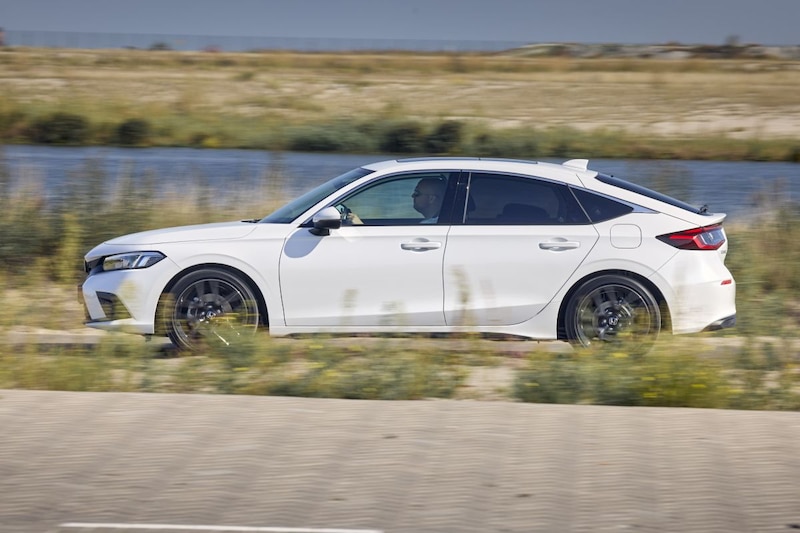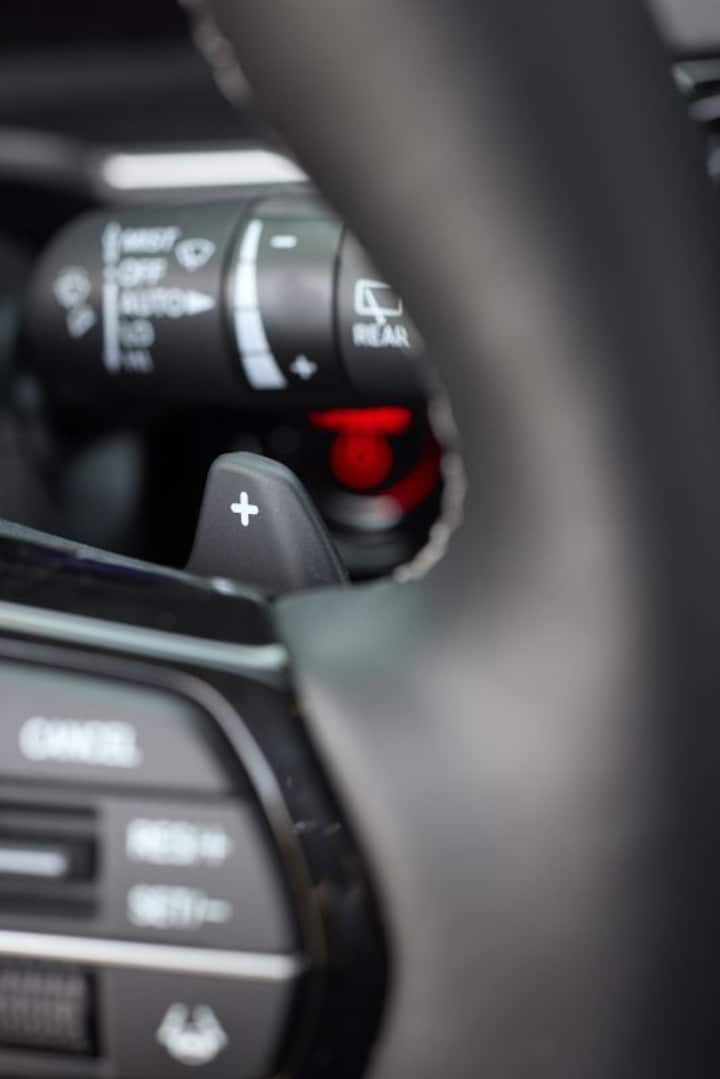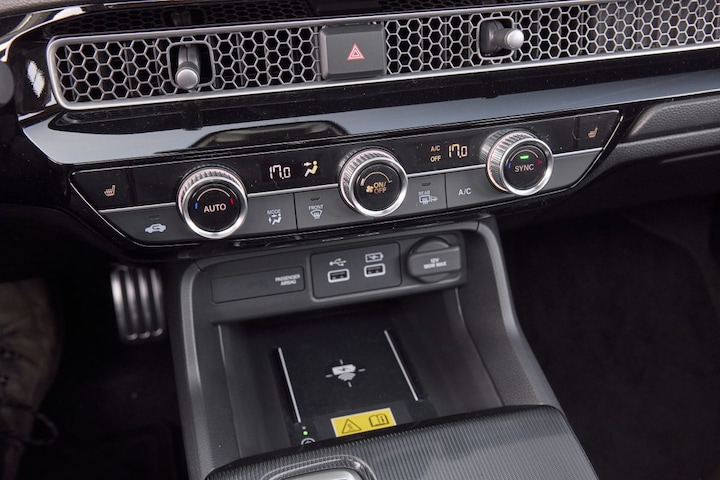Only one version, but a good one

With the previous Honda Civic you could only choose from regular combustion engines on petrol and diesel, for the new generation the Japanese brand is changing course and there is only a hybrid. How does this change of course work out in practice? And what else has Honda changed about the familiar Civic recipe? We test the new Civic e:HEV in the most complete Advance version.
The Honda Civic as a hybrid. That doesn’t sound very exciting…
Make no mistake: the new Honda Civic is a very interesting car. This is mainly due to the different technology. Its hybrid system works very differently from other cars whose combustion engine can rely on an electrical back-up. Honda’s e:HEV system consists of a brand new two-litre four-cylinder petrol engine, which operates on the efficient Atkinson principle. The block is good for a power of 143 hp and a maximum torque of 186 Nm. Okay, that’s not very impressive for a modern engine with a capacity of 2.0 liters, but here’s the thing: the petrol engine in the front of the Civic hardly interferes with the drive to the front wheels. This is done by an electric motor, which delivers 184 hp and a maximum torque of 315 Nm.
A second electric motor serves as a generator and is in turn powered by the combustion engine. Incidentally, there is indeed a link in the Civic. On the highway, for example, the four-cylinder is directly connected to the front wheels at part load via a fairly long, fixed transmission. The petrol engine simultaneously also charges the (small) battery, with which you can drive fully electrically at slightly higher speeds over considerable distances.
What do you notice on the way of that cumbersome technology in the Civic?
That depends on the situation. With a quiet driving style you drive electrically, and the Honda Civic accelerates very linearly and in complete silence. Only when you ask for more than about a third of the power do you hear that the combustion engine is involved. With faster acceleration, the system simulates gear changes by sometimes letting the four-cylinder drop back in the revs. Very fake of course, because as said there is no gearbox in the car. Still, it sounds quite funny, a bit like you’re in a Fast & Furious car, because even though the gearbox ‘shifts’ 28 times, the system never shifts down. However, it all works seamlessly and smoothly.

The ‘gears’ are simulated, these flippers are there to determine the degree of recuperation.
If you step on the accelerator even deeper, the Civic e:HEV switches back to a fully electric transmission. And then the Civic delivers excellent performance. From 0 to 100 is done in 7.8 seconds. Quickly overtaking another car, the Civic takes no effort at all. The intermediate sprint from 80 to 120 km/h takes only 5.8 seconds. Nevertheless, the Honda Civic e:HEV is very economical: we achieved an average of 1 to 20.3 in the test period, which is even better than Honda itself states. An impressive result for a petrol car with so much sprint power.
That sounds promising. So for driving pleasure, the Honda Civic is also good for you?
Absolute. We caught ourselves a few times during the test that we drove Civic much sportier than we normally do in a normal compact mid-sized car. The chassis of the new Honda also lends itself very well to this. The track-to-wheelbase ratio, as well as the remarkably sporty Michelin Pilot Sport 4 tyres, make the Civic feel stable at very high speeds and inspire confidence.
But also the enthusiast of a pleasant suspension comfort will certainly get his money’s worth in the Honda Civic. Due to the fine tuning of the shock absorbers, the suspension can do its job well. Thresholds and potholes in the road pass through above average, but your lower back is spared hard blows.
Add to that the very nice steering, good grip and excellent feedback, and you have an unexpected fun package. There are few front-wheel drive cars that steer as well as the Honda Civic, even though there is no emphatically sporty label on the Japanese hatchback. At most, the very sporty and noisy tires can eventually get on your nerves, especially on the highway it is quite buzzing in the wheel arches. That doesn’t fit in with the rest of the picture, which is just so refined.
What does the new Honda Civic look like inside?
Like the body design, the dashboard of the new Honda Civic looks less cluttered than that of its immediate predecessor(s). That looks calmer and more modern, and the solidity radiates towards you. Of course, the new Civic cannot escape digitization. The instrumentation is not very flashy and a tachometer is missing, but the power percentage meter does it with a sporty driving style. Fortunately, Honda sticks to physical buttons for, among other things, operating the air conditioning, and that improves the ease of use.

Beautiful details and excellent ergonomics.
The Civic has a very reasonable interior space to offer. Adult passengers can also easily lose their legs in the back seat. However, due to the steeply sloping roofline and the low car height, the headroom is quite limited. Thanks to the stretched silhouette of the new Civic, there is also enough space for the luggage. 404 liters fit under the large boot lid, with the couch flat you have a loading volume of 1,187 liters at your disposal. These are very neat figures for a car from the C-segment. The Civic is allowed to tow a trailer with a braked weight of 750 kilos.
Now Honda’s models aren’t cheap…
And the new Civic e:HEV is unfortunately no exception to that rule. Prices start around €37,500, the Advance version we tested costs an additional €5,500. Incidentally, competing models – such as the Toyota Corolla 2.0 Hybrid (from €41,495) or the Mazda 3 e-Skyactiv-X (€41,490 as Luxury with automatic transmission) – are not that much cheaper than our test Civic. Anyway, €42,875 for a compact mid-sized car still feels like a slap in the face …
What do you get as standard on the new Civic?
For the high price of the Civic, Honda does give you a lot of standard seasonings. For example, the cheapest Elegance version is already equipped with automatic air conditioning with two temperature zones, adaptive cruise control, heated seats, an electrically adjustable driver’s seat, front and rear parking sensors, a multimedia system with navigation and smartphone integration for Apple CarPlay (wireless) and Android Auto, LED headlights with high beam assist and 17-inch alloy.

The Sport version adds, among other things, a wireless phone charger, ventilation grilles for the rear seats, LED fog lights and 18-inch wheels. The Advance version takes the cake with its standard equipment, and offers, among other things, adaptive high beam, a panoramic glass roof, twelve loudspeakers (instead of eight), an electrically adjustable passenger seat, heated steering wheel, a 10.2-inch information screen (instead of 7 inches) and leather upholstery.
And what about the safety of the Honda Civic?
Honda does not want to leave anything to chance: regardless of the version of the Civic you order, you get all the safety features that Honda has to offer. That is quite exceptional in the compact middle class. We already mentioned the adaptive cruise control, which in the Civic is linked to the lane assistant and blind spot monitoring. This way the car always stays neatly between the lines and you won’t be short of eyes or hands in heavy traffic. There is a knee airbag in the front on both the left and right, and there is another airbag between the front seats that prevents you from giving your co-driver a headbutt in the event of a collision. Even the bonnet is lifted from its lying position when you hit a pedestrian or cyclist to reduce the risk of injury.
The choice of AutoWeek test coordinator Marco Gorter
There’s only one powertrain available, so there’s no choice on that front. You have a little more freedom with the versions, there are three. Secretly, the basic version Elegance is already quite generously equipped with, among other things, heated seats, separate air conditioning and a whole battery of safety systems. From a rational point of view, that is also the best choice, although the 18-inch wheels of the Sport version are a lot nicer.
.
– Thanks for information from Autoweek.nl